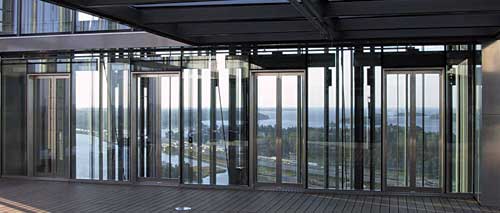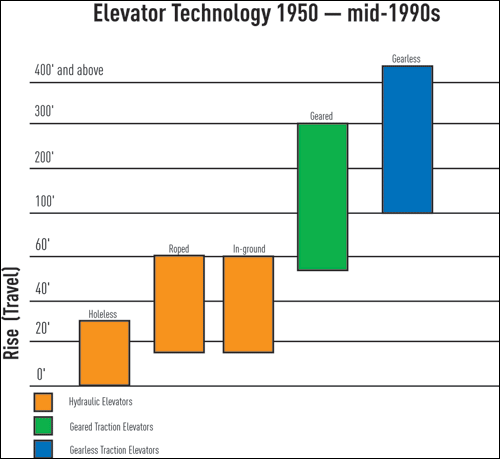New Elevator Technology: The Machine Room-Less Elevator
Learning Objectives:
- Compare the features and benefits of both traditional and new elevator technology such as the machine room-less elevator.
- Understand the design requirements for integrating new elevator technology within new and existing buildings.
- Evaluate how different elevator technologies impact energy efficiency and sustainable building design.
Credits:
Reportedly dating back to Archimedes, early prototypes of the elevator were installed in the royal palaces of Europe some 400 years ago. But it was not until the mid-19th century that the first modern elevators appeared in New York buildings, its technology driven by the need to move raw materials. Now, elevators are a standard feature for most commercial and public buildings of more than a single floor.
While technological advances were pushing many industries into new eras, elevators did not change significantly beyond a few system innovations. There was little reason why they should because the traditional technology worked-albeit with energy inefficiencies and significant space requirements. But, as manufacturers started focusing on the real costs of energy and hiding valuable real estate square footage inside hoistways and machine rooms, it responded, about 10 years ago, by introducing a new system. Named the Machine Room-Less (MRL) elevator-as the name implies, it does not require a machine room-the new elevator system saves space, is far more energy-efficient and avoids using polluting fluids. As owners increasingly demand energy savings and seek U.S. Green Building Council LEED® certifications, architects would do well to understand the features of the MRL and how to integrate it into their building design. Elevators fall into three general categories: hydraulic, traction and MRL.
Hydraulic Elevator
Passenger elevators generally employ two kinds of hoist mechanisms: hydraulics or roped traction systems. A Hydraulic elevator's function is based on Pascal's law of the incompressibility of fluids (the principle of hydraulics): an above-ground or in-ground piston mounted inside a cylinder is pressurized to raise and lower the car. Hydraulic systems are commonly used in low-rise buildings up to five stories. Speeds rarely exceed 150 feet per minute (fpm).
Originally the fluid used to drive the piston was water, hence the name hydraulic; today, the fluid is typically an oil-based "hydraulic fluid." There are four major components to the hydraulic system: a tank (fluid reservoir); a pump powered by an electric motor; a valve between the cylinder and the reservoir; and the cylinder.
Â
|
Â
The pump forces fluid from the tank into the cylinder. As the fluid collects in the cylinder, it pushes the piston up, lifting the elevator car. When the valve is opened, the pressurized fluid will take the path of least resistance and return to the fluid reservoir. When the car approaches the correct floor, the control system sends a signal to the electric motor to gradually shut off the pump and close the valve. With the pump off, there is no more fluid flowing into the cylinder, but the fluid that is already in the cylinder cannot escape (it can't flow backward through the pump, and the valve is still closed). The piston rests on the fluid, and the car stays where it is.
Â
Â
|
Â











